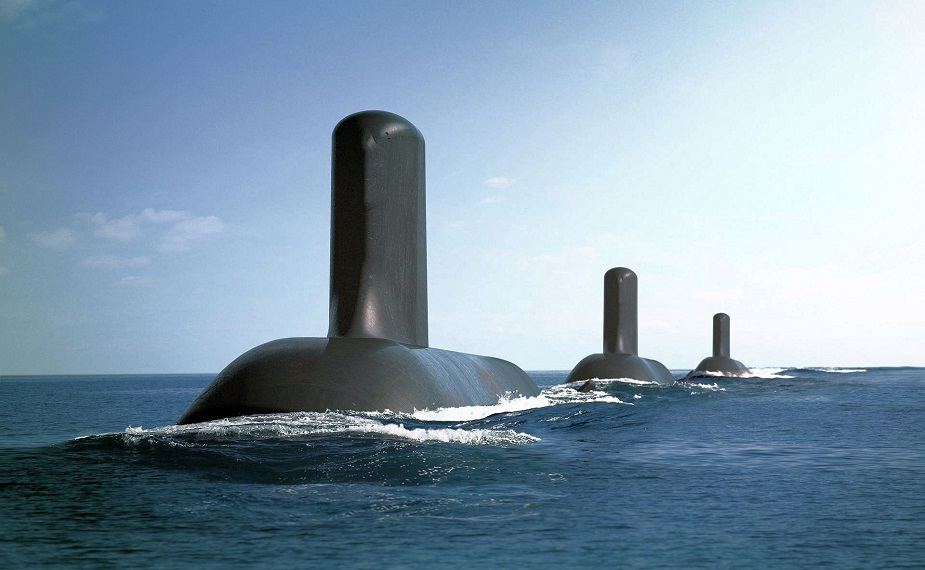Deeper collaboration between Australia and France in advanced sonar and naval robotics technology will flow from a research agreement announced in Sydney today during the visit of French President Emmanuel Macron.
 Artist impression: RAN future submarines. Naval Group image.
Artist impression: RAN future submarines. Naval Group image.
The Memorandum of Understanding (MOU) between Flinders University in South Australia, ENSTA Bretagne – a leading Graduate and Post-Graduate Engineering School and Research Institute in Brest, France, and Thales will deepen and extend well established research linkages between Australia and France in order to contribute to the future submarine program in Australia.
Thales Australia CEO Chris Jenkins said the President’s official visit was an opportunity to highlight the strength of the strategic relationship between Thales and France, a relationship underpinned by linkages like the research MOU announced today.
“This is all about attracting the best and brightest in both Australia and France to work on the challenges of the future submarine program, ensuring Australia gets the best capability. The MOU provides a long term framework for collaboration in naval robotics applicable to both submarine and surface ship sonars, including opportunities to share testing facilities, operate exchange programs and facilitate joint research projects. It builds on an already strong relationship between Thales and Flinders University in Australia as well as between ENSTA Bretagne and Thales in Brest, France.
Alexis Morel, Vice-President Underwater Systems at Thales, said discussions with Flinders University and ENSTA Bretagne had already identified two topics for research collaboration – one to design a demonstrator for the automatic connection of electro-optical links in a maritime environment and secondly for the development of USV test vehicles suitable to test autonomy algorithms on robotic swarms at sea.
“This collaboration will build Australian capability, provide internships for both undergraduate and post-graduate Flinders University students in France and contribute to design solutions for the future submarine program.
Flinders University Vice-Chancellor Professor Colin Stirling said the University was delighted to be partnering with Thales teams based in Australia and in France.
“This MOU will open up great opportunities for closer collaboration with Thales research laboratories and follows the recent announcement that Flinders University will be one of Thales Australia’s academic partners in the new Defence Co-operative Research Centre (CRC) for Trusted Autonomous Systems.”
ENSTA Bretagne Director Pascal Pinot stressed the fact that the MoU was a necessary base to start new Research projects between Flinders University, Thales and ENSTA Bretagne which would in turn reinforce the cooperation between the Defence ministries of the two countries.
“The MoU was built in order to lead to tangible Research work between us in the short term particularly in the field of underwater Robotics. It builds on the strength of all three participants in the framework of the increasing bilateral defence cooperation”.
Video on Australia's future submarine
Australia's Future Submarine Program:
The Australian Government selected Naval Group (then known as DCNS) as its preferred international partner for the design of 12 Future submarines for the Royal Australian Navy. The announcement was made on April 26 2016 by the Australian Prime Minister the Hon. Malcolm Turnbull, the Minister for Defence, Senator the Hon. Marise Payne, The Minister for Industry, Innovation and Science, the Hon. Christopher Pyne and The Chief of Navy, Vice Admiral Tim Barrett. DCNS was competing with the Shortfin Barracuda design against TKMS' Type 216 and Japan's Soryu class designs. Based on the French Navy Barracuda SSN currently in final stage of construction, Australia's future submarine will be will be 97 meters in length and 8.8 meters in diameter.
In September, Lockheed Martin was selected as the preffered combat system integrator. All 12 submarines are expected to be built in Adelaide (South Australia) with technology transfer from Naval Group.










